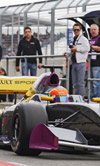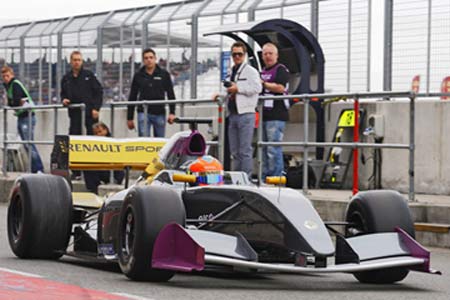Supercapacitors
 Formula racing in Europe has something of a complex 'ladder' scheme, by which drivers can try to reach Formula One, the pinnacle of the open-wheel sport outside the US. It might equally be described as a climbing frame, where there are many routes one can use to get to the top.
Formula racing in Europe has something of a complex 'ladder' scheme, by which drivers can try to reach Formula One, the pinnacle of the open-wheel sport outside the US. It might equally be described as a climbing frame, where there are many routes one can use to get to the top.
The various Formula Renault series though do provide a good graduation scheme, starting with relatively cheap cars powered by four-cylinder engines, through to the top series which, from 2012, is to be powered by a bespoke race engine for the first time. The 530 hp car further distinguishes itself from the other race series by being the first racecar to be designed without a battery for the 12 V supply on the car. I spoke to Renault-Sport's circuit technical manager Benoît Dupont about the replacement.
A decision was made to run without an onboard starter for reasons of saving mass; the current requirement on the car is much reduced once the starter motor is no longer a part of the equation. Instead a supercapacitor system will be used. This has been proven on other Formula Renault cars; the two-litre car uses a supercapacitor system to actuate the gear change. So, this is simply an extension of an existing system to accommodate the electrical requirements of the other systems on the car.
The supercapacitor system is covered in some detail in issue 57 of Race Engine Technology magazine (September/October 2011). The decision to dispense with the services of an onboard starter means there's no need for a large battery and, after examining a number of alternative options, a supercapacitor system was eventually chosen. The mass of the supercapacitor 'box' is 1.3 kg, and this incorporates the car's fuse box, which used to be additional to the 13 kg mass of the battery. Dupont says the combined mass reduction from removing the starter and using the supercapacitor system has roughly the same impact on the car performance as the switch to the significantly more powerful race engine!
So, how 'super' is the supercapacitor system? Well, a typical capacitor that you might find in an electronics kit will have its capacitance measured in microfarads or nanofarads, which are one-millionth and one-billionth of a farad respectively. The Renault system is 350 farads and operates at a nominal voltage of 15 V. In terms of capacitance it is many orders of magnitude greater than a typical capacitor.

The advantages of supercapacitors over the other obvious alternative (lithium ion batteries) are numerous. They are less affected by the number of discharge cycles, and have a much greater power density. This power density advantage allows them to accept and discharge energy at a high rate.
On the other hand, they have a comparatively poor energy density, and this means that to hold a given amount of energy, they score poorly against a lithium ion battery. These are the reasons that they are suitable for things such as gear-shift actuation, but not for energy storage for hybrid systems, where lithium ion systems are favoured.
Fig. 1 - The 2012 Formula Renault 3.5 car dispenses with a conventional battery in favour of a supercapacitor system
Written by Wayne Ward